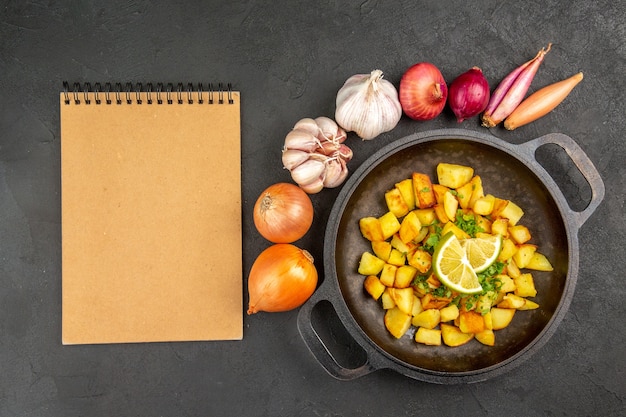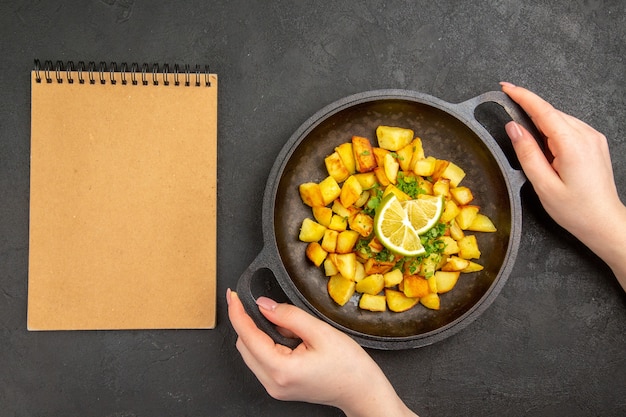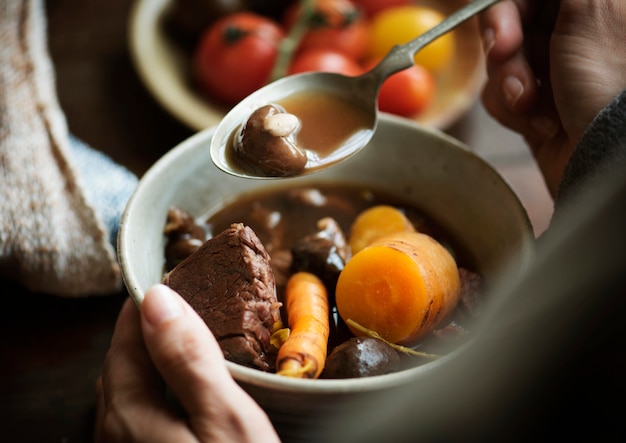(Part 1) The Essence of Stew: Choosing Your Base

A Symphony of Flavour: Selecting the Right Stock
The stock is the orchestra conductor, leading the symphony of flavours in your stew. It sets the stage, weaving in its own rich tapestry of aromas and depths. While store-bought stock can be a shortcut, I’ve always found homemade stock to be the secret ingredient to truly unlocking the potential of your stew.My personal go-to is a hearty bone broth. It’s a labour of love, but the results are incredible. I typically use chicken, beef, or lamb bones, along with a medley of vegetables like carrots, onions, and celery. The bones release their essence into the water as they simmer for hours, creating a rich, umami broth with unparalleled depth.
If time is a constraint, don’t be afraid to opt for good quality store-bought stock. Look for varieties free from additives and preservatives, allowing the natural flavours to shine through.
A Touch of Wine: Elevating Your Base (Optional)
A splash of wine adds another layer of complexity and depth to your stew, much like a seasoned musician adding a nuanced solo to a well-composed piece. A good quality red wine like Cabernet Sauvignon or Merlot works wonders, but don't be afraid to experiment with different varieties.The key is to deglaze the pot after browning the meat. This involves scraping up the flavorful bits stuck to the bottom of the pot with a wooden spoon and adding a little wine. It's like capturing the essence of the meat and the pan and transforming it into a delicious sauce for your stew.
(Part 2) The Art of Browning: Transforming Flavours

Choosing Your Meat: A Culinary Cast of Characters
You can use just about any meat for stew, but I have my personal favourites. Each meat brings its own personality to the table.- Beef: Beef chuck or shin is a classic choice for a hearty stew. The tough cuts break down beautifully in the slow cooking process, resulting in tender, melt-in-your-mouth morsels.
- Chicken: For a lighter, quicker option, chicken thighs are a perfect choice. They cook quickly and remain tender, making them ideal for midweek meals.
- Lamb: Lamb adds a rich, earthy flavour to any stew, making it perfect for a special occasion or a comforting weekend dinner.
The Browning Technique: Crafting Culinary Magic
The browning process is all about control and precision. You want to sear the meat in a hot pan, creating a beautiful, even crust on all sides.Start by heating your pan over high heat. It should be smoking hot before you add the meat. Add a little oil to the pan and then carefully place the meat, ensuring there’s enough space for it to brown properly. Avoid overcrowding the pan.
Cook the meat for a few minutes on each side, until it's beautifully browned. Don't worry about cooking it through; that will come later in the slow simmer. Once the meat is browned, remove it from the pan and set it aside.
(Part 3) The Mighty Veggie Crew: Adding Texture and Colour

Choosing Your Veggie Stars: A Cast of Characters
The beauty of stew lies in its adaptability. You can use whatever vegetables you have on hand, but here are a few of my go-to favourites. Each brings its own unique flavour profile and personality to the dish.- Carrots: Carrots add a touch of sweetness and a vibrant orange hue to the stew.
- Celery: Celery adds a subtle earthy note and a welcome crunch to the texture.
- Onions: Onions are a classic base for any stew, adding a rich, savoury flavour.
- Potatoes: Potatoes provide heartiness and texture to the stew. I like to use a mix of waxy and floury potatoes for the perfect balance.
- Mushrooms: Mushrooms bring a deep, earthy flavour and a wonderful umami kick to the party.
- Tomatoes: Tomatoes add a touch of acidity and sweetness, balancing the rich flavours of the stew.
Prepping Your Veggie Squad: Bringing Order to the Chaos
Once you've chosen your vegetable cast, it's time to prep them. I like to chop them into bite-sized pieces, ensuring they cook evenly and are easy to eat.For sturdier vegetables like carrots and potatoes, consider giving them a quick roast in the oven before adding them to the stew. This brings out their natural sweetness and adds another layer of flavour to the dish.
(Part 4) The Slow and Steady Simmer: Unveiling Depth
This is where the real magic happens, the slow and steady simmer that allows the flavours to meld and the meat to become incredibly tender. It's like letting a good bottle of wine breathe, allowing its aromas to develop and its flavours to deepen.Time is Your Ally: A Symphony of Flavours
The key to a truly delicious stew is patience. The longer you let it simmer, the richer and more complex the flavours become. I often start my stew in the morning, letting it simmer gently on the stovetop for several hours. Then, I transfer it to the oven for the rest of the day, allowing it to continue to simmer slowly and develop its full potential.Seasoning with Intention: Finding the Right Balance
Seasoning is crucial. As your stew simmers, don't hesitate to taste and adjust. Salt and pepper are the foundation, but don't be afraid to experiment with herbs and spices.I always add a sprig of thyme, a bay leaf, and a few peppercorns to my stew. They add a beautiful aroma and enhance the flavour. Experiment with different herbs and spices to discover your own perfect combination.
(Part 5) Finishing Touches: The Art of Refinement
You've come so far, and now it's time to add those finishing touches that transform your stew from good to great. It's like adding the final embellishments to a masterpiece, bringing it to life.Thickening the Broth: Adding Body and Texture
A good stew should have a thick, rich broth. You can thicken it using a variety of methods, each adding its own nuances to the texture and overall feel of the dish.My personal favourite is a simple cornstarch slurry. Just whisk together a tablespoon of cornstarch with two tablespoons of cold water. Slowly stir it into the simmering stew until it reaches the desired thickness.
Alternatively, you can use a roux, a mixture of flour and butter cooked together. Add it towards the end of cooking and stir until it thickens.
A Final Burst of Flavour: Adding Depth and Complexity
This is your chance to get creative and personalize your stew with a final touch of flavour.For a classic touch, add a tablespoon of Worcestershire sauce. It brings a rich, savoury depth that complements the meat and vegetables beautifully.
If you're looking for something more exotic, try adding a spoonful of harissa paste for a fiery kick.
And for a touch of creaminess, stir in a dollop of cream or a swirl of yoghurt just before serving.
(Part 6) Serving Your Stew with Love: A Celebration of Flavour
Your stew is ready to be enjoyed, and remember, this is a celebration of good food and good company. It’s about savouring the flavours, appreciating the journey, and sharing it with those you love.The Perfect Accompaniments: A Symphony of Texture and Flavour
There are so many delicious ways to serve your stew, each adding its own unique texture and flavour to the experience.A classic pairing is a crusty loaf of bread, perfect for soaking up the rich broth and mopping up every last drop.
For a more elegant touch, serve your stew with a side of mashed potatoes or rice. Or, for a lighter option, try a simple salad.
Let the Feast Begin: A Moment to Cherish
As you gather around the table and enjoy your stew, take a moment to appreciate the journey that led to this moment. The careful selection of ingredients, the meticulous browning of the meat, the long, slow simmering, and the final touches that brought it all together.It's a testament to your dedication and love for good food, and a reminder that the most delicious meals are often the ones made with love and shared with those we care about.
(Part 7) Mastering the Stew: Tips and Tricks for Success
The beauty of stew lies in its adaptability and the room it gives for personal expression. Here are a few tips and tricks to help you master the art of stew-making and create truly delicious masterpieces.1. Embrace Experimentation: A culinary adventure
Don't be afraid to experiment with different ingredients and flavours. Try adding different herbs and spices, using a variety of vegetables, or incorporating different types of meat. The possibilities are endless!2. Slow and Steady Wins the Race: The Power of Patience
Slow cooking is essential for unlocking the full potential of your stew. Allow it to simmer gently for several hours, giving the flavours time to meld and the meat to become incredibly tender.3. Keep It Simple: Letting the Flavours Shine
A good stew doesn't need a million ingredients. Focus on using quality ingredients and letting the natural flavours shine through.4. Taste as You Go: Finding the Right Balance
Seasoning is crucial. Taste your stew as you cook, adding more salt, pepper, or other herbs and spices as needed. Adjust the seasoning throughout the cooking process to achieve the perfect balance of flavours.5. Make It Ahead: The Gift of Time
Stews are even better the next day! The flavours have time to meld and intensify, creating a truly rewarding experience. Feel free to make your stew ahead of time and reheat it before serving.(Part 8) The Art of Storing and Reheating: Preserving Your Masterpiece
Now, let's talk about storing and reheating your stew, ensuring that its deliciousness lasts and that you can enjoy it again and again.Storing Your Stew for Future Delights: Keeping the Flavour Intact
Once your stew has cooled completely, transfer it to an airtight container and store it in the refrigerator for up to three days.You can also freeze your stew for up to three months. Label it with the date and let it thaw overnight in the refrigerator before reheating.
Reheating Your Stew for Maximum Flavour: Bringing Back the Warmth
When you're ready to enjoy your stew again, there are a few different methods for reheating it.You can reheat it gently on the stovetop over low heat, stirring occasionally until it's heated through.
You can also reheat your stew in the oven at a low temperature. Transfer it to an ovenproof dish and bake for about 30 minutes, until it's heated through.
For a quick and easy option, you can reheat your stew in the microwave. Just make sure to cover it with a lid to prevent splattering.
(Part 9) Beyond the Basics: Exploring Delicious Stew Variations
The world of stew is full of delicious variations, each offering a unique flavour profile and culinary experience. Let's explore a few to inspire your own culinary adventures.1. The Hearty Beef Stew: A Classic Comfort
This is a classic stew that never disappoints. Use beef chuck or shin, and add hearty vegetables like carrots, potatoes, and onions. Season it with salt, pepper, thyme, and bay leaf. It's a dish that embodies the essence of warmth and comfort.2. The Comforting Chicken Stew: A Lighter Option
This light and flavourful stew is perfect for a midweek meal. Use chicken thighs, and add a mix of vegetables like carrots, celery, potatoes, and mushrooms. Season it with salt, pepper, rosemary, and parsley. It's a delightful balance of flavours and textures.3. The Rich and Savoury lamb stew: A Special Occasion Treat
This warming and flavourful stew is perfect for a special occasion. Use lamb shoulder or shank, and add root vegetables like carrots, potatoes, and parsnips. Season it with salt, pepper, rosemary, and garlic. It's a dish that celebrates the richness of flavour and the indulgence of good food.4. The Vegetarian Bean Stew: A Hearty and Nutritious Option
This hearty and flavourful stew is perfect for vegetarians and vegans. Use a variety of beans, such as kidney beans, chickpeas, and lentils, and add vegetables like carrots, celery, potatoes, and onions. Season it with salt, pepper, cumin, and paprika. It's a delicious and satisfying meal that showcases the versatility of beans.5. The Spicy Sausage Stew: A Warm and Inviting Delight
This hearty and flavourful stew is perfect for a chilly evening. Use spicy sausage, such as chorizo or andouille, and add vegetables like carrots, celery, potatoes, and onions. Season it with salt, pepper, paprika, and cayenne pepper. It's a dish that warms you from the inside out.(Part 10) FAQs: Answering Your Questions
1. Can I use frozen vegetables in stew?
Absolutely! Frozen vegetables are a great option for making stew. Just make sure to defrost them before adding them to the pot.2. How do I know if my stew is cooked through?
The meat should be tender and easily shredded with a fork. The vegetables should be soft and cooked through.3. How long can I keep stew in the fridge?
Stew can be kept in the fridge for up to three days.4. Can I freeze stew?
Yes, you can freeze stew for up to three months.5. What are some other ways to thicken stew?
Besides cornstarch and roux, you can also use flour, potato starch, or even mashed potatoes to thicken your stew.And there you have it! Your comprehensive guide to making delicious stew. Now, go forth and conquer the world of stew, one simmering pot at a time. Remember, the most important ingredient is a love for good food and the desire to create something truly special. So, put on your apron, gather your ingredients, and let the stew-making adventure begin!Everyone is watching

How to Cook Frozen Lobster Tails Perfectly: A Step-by-Step Guide
RecipesLobster. Just the word conjures up images of lavish meals, special occasions, and a taste of luxury. But let's...

Pigs in a Blanket Cooking Time: How Long to Bake for Perfect Results
RecipesAh, pigs in a blanket. Just the name conjures up images of those delightful little parcels of crispy pastry en...

Pork Fillet Cooking Time: How Long to Cook It Perfectly
RecipesPork fillet, or tenderloin as it's sometimes called, is a real favourite in our house. It's so versatile, and...

The Ultimate Guide to Cooking Delicious Frankfurters
RecipesLet's face it, we all love a good frankfurter. It's a classic, simple, and always satisfying. But let's be rea...

Wolf Meat Recipes: A Guide to Cooking Wild Game
RecipesLet's be honest, you don't see wolf meat at your local butcher shop every day. It's a bit of a wild card, but ...
